|
NMIT Working Papers present preliminary
formulations of new data and thinking from ongoing social
science research on the economic, cultural, policy and social
implications of new media, communication and information
technologies in the contemporary Middle East.
Views expressed are those of the
authors, who welcome feedback and comment from
users.
Need a translation?
|
Technology,
Media, and the Next Generation in the Middle East
Jon W. Anderson, Catholic
University of America ( 1)
Paper delivered at a the Middle East Institute,
Columbia University, Sept. 28, 1999.
SUMMARY: New media and rising levels of
education are resetting the parameters of citizenship across
the Arab countries of the Middle East. These developments are
uneven: regulation of and access to information vary
considerably and in the short run are contradictory. But their
overall context is an expanding public sphere with
unprecedented opportunities for participation, a widening,
more diverse public with widening transnational ties, and
spaces for new interpretations and new interpreters. For some,
these opportunities are associated with globalization,
particularly in finance and labor markets. For others, they
evoke the contradictory pulls of localization, particularly in
culture and politics. Media and migration link the two; and in
the longer run, the development of new media and rising levels
of education intersect with regime transitions also already
underway that regionally may be represented as from "Ottoman"
to modern, even "postmodern" styles in government and society,
as those are locally understood, and increasingly figure in
questioning "Who is Arab/Arabian now?" At the center of these
developments, shifting media regimes constitute a key arena
for redefining the public sphere, including what is public and
what registers as public action and identity. This shift is
already underway, and its parameters, if not their impacts,
can be identified where they occur first, in the meeting of
"down-market" technologies of new media and "up-market" people
with education and inclination to make use of them to advance
claims - and thereby to define - the public sphere.
____________________
NEW MEDIA are intersecting changes in what it means to be
Arab and an emerging public sphere in Arab countries. Impacts
of new media to date have been clearest in the surrounding
countries of Arabia's own "near abroad" -- from the role of
cassette sermons in Iran's revolution(2)
to the dramatic emergence of Turkey as "one of the most media
saturated Muslim countries in the world"(3)
since its sudden deregulation of broadcasting in the 1990s.
Both of these developments are increasingly evident in the
Arab world. Each brings "distant others" and "hidden others"
into the households, cafes, diwaniyya, and majles where people
exchange information, news, entertainment, and talk. There is
a dramatic rise in mediated communication that is passing to
and through more hands with access to skills and technology to
produce and consume it. The keys to this development, broadly,
are
- the wider circulation that new media technology from
cassette recorders to multichannel television, pulp novels
and pamphlets, mobile phones and even the Internet, afford
to communications previously restricted if not to "private"
then to face-to-face communication resulting in
- migration of messages (a) between media and (b) from
narrower or more restricted publics to wider ones, which are
themselves characterized by
- rising levels of mass, particularly mass higher,
education throughout the region. New media figure in
expanding forms of cultural expression that include
- opportunities to imagine and experience additional,
alternative selves in the context of
- fragmentations of authority to adjudicate cultural
authenticity and social ideals.
New media, and the down-market migration of technologies
behind them are linked -- in some cases, intimately, in others
coincidentally -- to the coming of age of the Arab world’s
first television generation, reconnection with Arab
communities overseas, "globalization" in finance, trade,
media, and communications that influence all aspects of Arab
life today in an information revolution in the Arab world that
is well underway. Awash in a media explosion that feeds and
feeds on wider participation, existing and emerging elites are
eager to join the world information community and to connect
with the emerging global post-industrial society denominated
by trade in information services, which are increasingly
cultural. And ever larger portions of the population are
equipped to do so by the spread of mass education and of
technologies of communication, particularly technologies for
producing mediated communication. Here, I focus on the fateful
conjuncture of increasingly "up-market" populations and
"down-market" technologies that, particularly in the form of
new media, are beginning to reverse the mass media revolution
of the nation-building period of de-colonization.
An initial caveat: It is fatally easy to overinterpret new
media by focusing speculatively on one or another of these
dimensions and in terms of impacts that project from narrow
experiences in the West. Technology does not have a life of
its own, but accumulates new users and new uses that are
always mediated through contexts which impart additional
meanings and significances to it. Against the technological
optimism that drives many global interpretations today should
be set the actual historical experience of previous
technological innovations -- from print to railroads to the
telegraph and radio -- that more properly may be seen to have
altered balances and acquired social forms and relations that
were "new" primarily in relation to the technology. In the
industrialization of the West, these altered balances included
the rise of managerial classes, the relocation and separation
of processing goods and processing services, realignments of
boundaries between home and work, all of which were quite
uneven in their "impacts" and developments.(4)
Technology has a social life because it enters social life and
alters the balances of values and practices built into
technology in ways that at any one time are mixed, even
paradoxical.
This revolution is, indeed, paradoxical. It features broad
convergences of different types of data in to a single
(ultimately digital) type, of messages into a single stream,
of work and leisure into a communication activities that also
foster increasing divergence and diversity of interests
depending on information that is made or allowed to flow.(5)
Facilitating the flow of financial information, transactions,
and tracking that add up to "electronic commerce" also
facilitates the flow of cultural (including political) content
around barriers previously erected. Media are "enculturated"
both by new uses and by censoring external and monopolizing,
or at least restricting, internal communication. Throughout
the region, senses of a new opportunity, even of a second
chance, to ameliorate regional eclipse of the Middle East in
the industrial period encounter reservations less about a
"digital divide" than about cultural confrontations, which
some see as opportunities and others as threats to prevailing
hegemonies in culture, identity, rights to interpret and to
represent in public. In terms of media, some of these conundra
resolve as a major shift of communications regimes in the
region from mass to post-mass media, from cultural and social
forms favored by single-sender communication regimes to
cultural and social forms facilitated by multiple senders and
choosy receivers. The technological-media shift is between
models of communication and the sorts of communications those
models favor.
The regime of mass media.
The communications ecology of the Middle East for the past
40 years has been shaped by a mass media regime that has a
strong structural "fit" with authoritarian, centralized
regimes. Liberal hopes that mass communication would broaden
horizons and bring an overall decrease in isolation,
articulated in Daniel Lerner's The Passing of Traditional
Society (New York: The Free Press, 1958), met the
realities that mass media’s one-to-many model of
communications fits particularly well to authoritarian states
and centralized control of the means of communication. This
model favored ritual communication of the theater state and
protocol news: public life was dominated by representations of
state power, authority, and symbolic legitimacy, which
register the solemnities of exchanges between authorities,
from which not only the masses but also whole classes (such as
the bourgeoisie in Syria under the Baath and professionals
nearly everywhere) are excluded or relegated to spectator
roles. Like early-modern states, such states make theatrical
use of media to stage symbolic exchanges of virtue, and their
ideal observer is their own mirror image: a homogeneous
citizenry culturally reflecting a politically unified state.
While mass media have been instrumental in defining a mass
citizenry, the actual content of those definitions has been,
on the whole, pre-modern in post-colonial states that were at
best mixes of modern and pre-modern means and meanings.
Citizens do not necessarily cooperate with this program.
Far from being molded in its images, they also experience
social distance from them, a disconnect between the rituals of
state and everyday life. The typical response is to develop
practical senses of distance, irony, deconstructionist skills,
cynicism, and conspiracy theories of politics as "hidden".
Citizens do not see themselves in media, or they see
flattened, partial versions of more complex realities
distorted by focusing on too few variables. They develop
habits of media consumption that reintroduce interaction into
one-way reception by drawing on understandings and practices
of everyday life, and exaggerating them, particularly their
emphasis on agency. One example is the elaboration in tandem
with mass media of conspiracy theories that, far from the
psychopathology often attributed to them by observers, are
rationalizing responses that reduce social distance by
emphasizing the sort of agency that characterizes everyday
interaction.(6)
Each new medium -- from print that introduced newspapers in
turn-of-the-century Middle Eastern countries to broadcasting
in the post-colonial period -- that was hailed as a tool for
development, education, enlightenment by elites has made
popular conspiracy theorizing both more widespread and ever
more ironic. A novel parodying conspiracy theories in the
1970s became the basis of a popular television series in Iran,
for example.
More structural responses include the widespread habit
throughout the region of group listening or watching
broadcasts. Coffee-houses, diwaniyya, and salons in private
homes are social settings in which intimates consume, and
domesticate, messages from authorities and "complete" them
through interpretive practices that betoken trust not in the
messages, and certainly not in distant senders, but in circles
of intimates to decode messages socially. A linked practice is
listening to and comparing news from several sources,
deconstructing them against templates of interests the sources
are supposed to represent. A typical evening's activities in
guest houses across the region includes discussing and
comparing the "news" from various sources, creating a local
composite out of what was said and what the listeners could
bring to interpreting it.
Thus the broadcast regime of protocol news and one-to-many
communications that emphasized reception of acceptable,
authoritative messages was less complete than the ideal type
might suggest. The problematic qualities of this media regime
fostered a re-socialization of its messages by listeners who
became interpretive adepts and, to that extent, rebalanced its
still fundamentally asymmetrical structure. This
resocialization of reception into something more like, but not
quite, interaction lays the basis for rapid up-take of
post-mass media. Habits that complement reception with
creative responses, and created demands for access to the
tools of communication that began with cassette recorders now
extend to multichannel broadcasting from satellites, to the
Internet, and ever cheaper and more abundant telephones.(7)
The changing audience.
Mass media are a little over a century old in the Arab
Middle East. Within a generation of the first newspapers in
Arabic in Egypt in the 1880s, there were vernacular presses
from Morocco to Afghanistan. While largely addressing an
elite, these included new elites beyond the world of the
manuscript and for whom the mediated word was a central
feature of their identities. Prominent examples include the
first generation of Islamic reformers, from Mohammed Abduh to
Mowlana Maududi, who were not the traditional spokespersons of
madrassa but almost uniformly journalists, a role created and
fostered by mass media. They spoke from and to an elite itself
fostered by the spread of literacy and its vehicle education.
After World War II and with decolonization, this narrow
intelligencia and its context expand dramatically in two ways.
One is the expansion of mass media to mass audiences through
broadcasting. First radio and then television became
ubiquitous in the last fifty to twenty-five years, and
everywhere a state monopoly, also everywhere devoted to
nation-building and the creation of national citizenries.
Linked (by policies of nation- and citizen-building) to the
emergence of truly mass media is the rise of mass education,
and particularly of mass higher education throughout the
region. The result is a generation-long rise in access to and
levels of education.
The significance of this rise, Eickelman has argued,(8)
is a broad "empowerment." Eickelman emphasizes that the spread
of mass, and particularly of mass higher, education
"empowered" in the Arab context by breaking practical
monopolies that were previously the privilege of elites
schooled in esoteric techniques and media of sacred texts,
commentaries, and handbooks. Education gives access to texts,
bypassing authorities vested in their media, and, more
importantly, to "intellectual technology" to interpret and use
them. Beyond these first-order balances are more structural
ones: modern education promoted by the state and alternative
to madrasa forms gives access to techniques ultimately based
in science and empirical analysis that challenge traditional
practices, undermine their legitimacies, and expand the public
space marked by mediated communication.(9)
Instead of the text-exegetical methods passed on in madrassa
to interpretive elites, for instance, mass education passes on
skills and habits that bypass those of traditional
authorities, that feature direct access and direct
interpretation, often in social settings that are mediated
differently from those of traditional learning. It broadens
the range of skills that represent "education" over "classical
education" (much as public schools did to Latin schools of
19th century America), as well as the social range and actual
numbers of educated persons, their opportunities, confidence,
and agency. It rebalances forms of migration in which migrants
take their "capital" with them, and broadens the range of and
access to mediated communication, which depends on and
privileges education as its "background".(10)
This is not a simple or by any means well-understood
relationship, and its understanding in our own society is
fraught ideologically. But empowerment is not the only outcome
of spreading education, nor only of education, and neither is
disempowerment of mass media. Instead, the two interact in
some unplanned ways that foster skills, particularly of agency
and particularly suited to expanding the public sphere and
identities available in and through it. More productively, it
might be put that education broadens the contexts in which
mediated communications figure and translate technique into
identity, method into message.
This background may be indicated in a few simple
charts of some of the features of the next generation. First,
literacy rates of those 15 and older (Fig. 1) may serve as a
proxy for participation in mass education, which is variable
throughout the region.
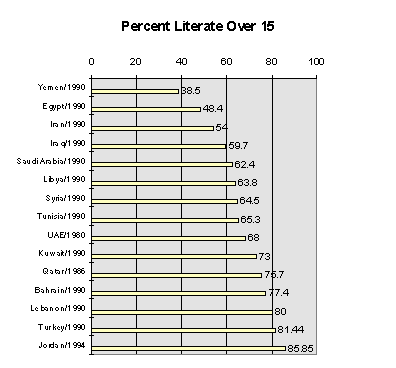
Figure 1.
Literacy Rates in Middle Eastern countries
(Source: US
Census Bureau International Database)
Second, the median age of populations in Arab
countries is about 20, roughly in line with LDCs overall and
just over half the median age of populations in MDCs (whose
populations are "ageing"), as represented by the United
States.
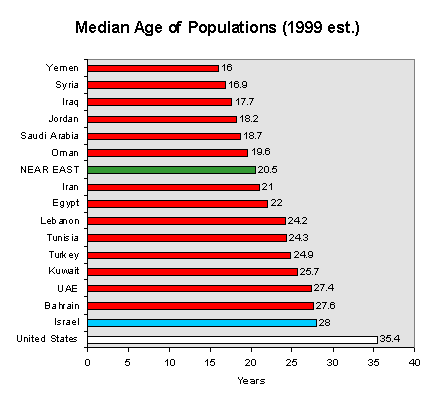
Figure 2.
Median Ages in Select Middle East Countries
(Source: US
Census Bureau International Database)
And Arab countries’ rates of population growth
are among the highest in the world, higher even LDCs overall
and, although trending in the same direction (downwards), are
twice the rates of MDCs..
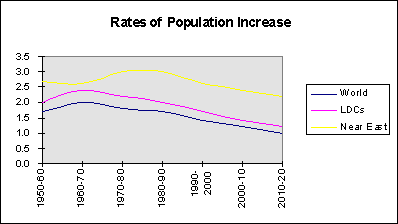
Figure 3.
Projected rates of increase.
(Source: U.S. Census Bureau
International Database)
So their populations are getting younger, and
more educated. The next generation is not only quite large,
but larger than the ruling generations across the board...
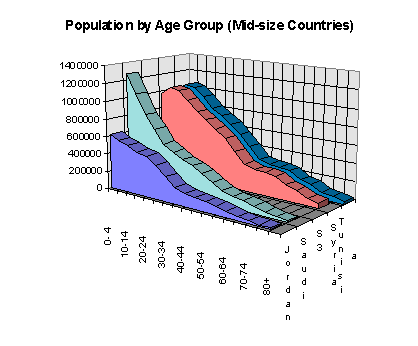
Figure 4.
Mid-size countries with low (Jordan) middle (Syria, Tunisia)
and high (Saudi Arabia) fertility (Source: U.S. Census Bureau
International Database)
... particularly in the larger countries of the
region: Iran, Turkey, Egypt...
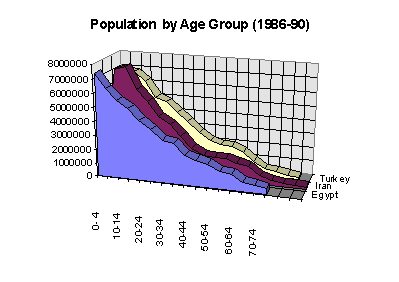
Figure 5.
Population by age group
(Source: U.S. Census Bureau
International Database)
... and also more educated. Jordan provides an
extreme example, with the highest overall reported literacy
rates of Arab countries, and demonstrates the cumulative
effect of rising mass education as younger, more educated
cohorts pass through the population.
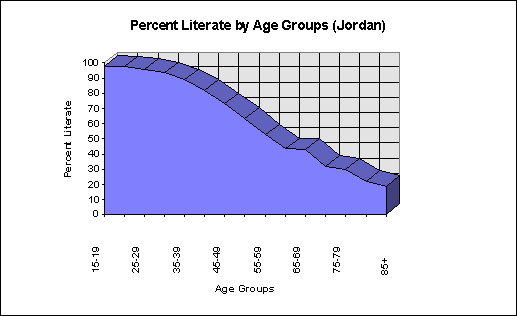
Figure 6.
Increasing literacy in younger age groups
(Source: U.S.
Census Bureau International Database)
Demographically, the context into which the information
revolution will work its "effects" includes coming generations
that are larger and more educated than the first television
generation in the region that is now coming to power. The
expectations and capabilities of the next generation are both
the most significant underlying feature that can now be known
(unlike, say, potential changes in political economy or regime
successions) and (b) directly shaped by media and experiences
with media that increasingly shift from receptor models to
more interactive ones.
Post-mass media: the information technology
revolution.
The media scene into which these generations are maturing
is changing. If the signature communicative relationship of
the mass media revolution in the Middle East was reception,
under a regime of one-to-many senders to receivers or mass
audiences for state monopoly broadcasters, the counterpart of
post-mass media is more interactive communication in which the
senders multiply and social distance between senders and
receivers diminishes by a confluence of an increasingly
up-market populace with down-market technologies. New media --
including the cassette recorder but also widening availability
of telephones, multichannel television but also pulp fiction,
comic books, pamphleteering, and, on the horizon, the Internet
-- share a general characteristic. They level the
communication playing field between sender/producer and
recipient/consumer of messages. The dramatic example, not
recognized at the time, of sermons of Ayatollah Khomeni and
other banned religious figures circulating via cassette in
pre-revolutionary Iran, has been joined by not only the
popular circulation of sermons today, but also folk music,
pirated commercial recordings, and in periods of revolution
"night letters" (shab-name) as the originally written
versions were called. These technologies are linked, as the
delivery of Khomeni’s sermons via telephone from France
demonstrated a generation ago, or the mix of amateur and
pirated commercial material in any cassette-shop today.
Convergence is happening on the street and in homes. Moreover,
messages cross boundaries between media and thereby find new
audiences, new circulation to additional social networks. The
sharing of cassettes signals trust and complicity, not so much
in the content of the messages, which are incomplete in
themselves, but in circulating them even before individual
consumption of their contents.
Technology for producing and sending messages becomes as
available to consumers as technology for receiving at the same
time that capacities to produce are rising with education.
That is, technology enables participation, and technologies
that reduce the social and cognitive distance between sending
and receiving -- as do telephones, cassette recorders, the
Internet -- increase the number of senders, producers,
selecters, and brokers of cultural "content". The pattern
already set in motion in the practices and habits developed to
level the asymmetrical relations of mass media and make
consuming them more reciprocal is extended with the advent of
multichannel satellite TV, which came first to Turkey and
Lebanon and has spread to all countries of the region.On the
receiving end, there is now choice where there was little
before, a change that foregrounds choice itself as part of
media consumption. On the sending end, there are pressures and
opportunities to create or to broker others’ creation of
content and to open the field both to international standard
broadcasting -- represented, for instance, in game shows and
in al-Jazeera TV’s migration of debate-and-discussion formats
from salons to the air -- and to local forms, as in 'Iqra's
religious family broadcasting from Dubai. Syria has recently
spawned a significant soap opera industry, (11)
which finds markets across the region in the extra broadcast
capacity now available. So while choice among 30+ channels (as
in Egypt today) is a very limited form of interaction, it is
nevertheless a higher level of engagement (with more to come)
than with two government channels. Moreover, some of the
locally most compelling material that comes across is, like
Al-Jazeera, itself about participation, which is further
invited in the form of viewer call-in and actively sought out
through informal market research.
The participation in interpretation that previously
occurred in coffee houses and reception rooms now extends to
what is broadcast, directly in the form of call-in shows that
can interact with viewers and, perhaps more importantly
(because it is part of the draw) indirectly in loosening of
formats to include live, on-air discussion and debate in which
something other than the solemnities of state and religion can
be witnessed. In other words, media that used to feature
ritual representations of authority now feature both practices
and representations of interaction that are familiar, that
have been honed through a generation of television and radio
consumption in more ordinary social settings, that actively
feature participation, and that represent (show) it. This is
news and TV drama as "edu-tainment."(12)
Numbers of participants are small, to be sure, and confined to
elites that both feel entitled to participate and have the
wherewithal; but demographics show those elites to be growing
with populations that are becoming younger and more educated.
One of Jordan's former Ministers of Information, who presided
over introduction of the Internet and ran an innovative
chat-line called "Ask the Government," recently put it that
the "real elite [in the information age] are the youth."(13)
The Internet Model.
This is TV on the Internet model, which features seeking
over reception, levels senders and receivers, circumvents
authority or is self-authorizing, and interactive in practice.
The structural significance of choice and participation
introduced by Al-Jazeera TV and before it MBC, or conveyed
through the broadening entertainment choices offered by Orbit
and ART, is the practical convergence with the Internet model
that choice and participation bring. On the level of
underlying technology, convergence between electronic media -
telephone, broadcasting, cable, data - is already well
underway worldwide and actively pursued by companies in these
separate businesses expanding into others. In the Middle East,
for instance, Zak-Sat based in Kuwait offers not only
television but also Internet service (the downlink portion
only, for the moment); telephone companies in the Gulf are
getting into the cable business, and there are similar
convergences of mobile phone companies with satellite
broadcasting and Internet services in Saudi Arabia. Beyond
technological convergence in the carriers is a more
sociological, convergence of senders and receivers into an
interactive community, and with that of communicative models
toward the Internet standard that is interactive,
decentralized, and puts up very little more barrier to send
than to receive.
These barriers can still be formidible in a region where
all countries censor public media, even if not all countries
extend this censorship to the Internet itself. In Jordan,
Egypt, and Morocco, the Internet enjoys privileged exemption
from censorship applied to print and broadcast media, and from
the Arab Postal Union's rules against mailing of video and
audio cassettes. Elsewhere, notably in Saudi Arabia and the
Gulf, models for structuring and providing access to the
broadcast media are applied (inconsistently in the smaller
countries of the Gulf, rigorously in Saudi Arabia) to the
Internet.
Much initial concern over the Internet in the region has
focused, from those in authority positions of all sorts from
head of state to religious spokesmen to head of family, on
"culturally inappropriate" content. Such concerns are real
enough and correspond to reactions in 17th century Europe when
the novel was invented, spread by means of cheap printing, and
for that decried as not only vulgar but corrupting. Likewise,
communication on the Internet model is unstructured by
existing canons and enforcers of authority; it puts an
unaccustomed measure of agency (not to mention of
self-authorization) in the hands of a browser, a
channel-surfer, a mobile-phone user, a desktop publisher. On
the receiving end, the freedom to look implies a corresponding
freedom to sample alternative role models, alternative
legitimations and models of authority, not just to the state
but in competition with religious authorities and also the
family. It is not the consumption of forbidden images that is
at issue in the final instance but, more fundamentally, the
opportunity to study them in some sense "objectively" (as
objects), to identify with them (as independent subjects), and
then to produce them. This is a sort of experimentation
usually limited to artists, who in many countries of the
region are domesticated to existing structures through state
organizations for employing them.
This loosening of boundaries is important for exposing
variety within "Arab" culture and creating the opportunity to
see alternative selves as well as diverse others. One of the
first meta-messages that comes with multichannel television or
with the Internet model toward which it tends is not of Arab
uniformity or the transnational extent of Arab culture.
Certainly, that is present in a linguistic sense, as it is for
Spanish-speakers or in the Chinese linguistic world; but
following a generation of uniformitarian messages by
nation-building states, the first lesson enhanced
communication brings home is the extent of Arab diversity and
want of uniformity. It begins with language and extends to
visible manners and dress that can be seen on television. The
current highly transnational register of multichannel Arab
television (much of which is based overseas) is even more
patent in the Internet, whose Arab content originated in and
to a large extent is still dominated by the Arab diaspora.
Both transnational television and Internet expose differences
among Arab countries, regimes, local cultures, customs (such
as of dress, female comportment, public life), education,
vocabulary, diction, speech habits and expressions. Arabs are
not unaware of such differences in the abstract, but
practically they are thrown up and practically interacted with
as never before through the current information revolution.
No single dimension, such as of westernization, can
accommodate this variety as experience with it deepens and
becomes ubiquitous. What once was an elite experience,
such as of the rich sampling the west in still-Arab
environments of pre-war Beirut or in contemporary Cairo, in
effect moves down-market also. It becomes more accessible to
more people, if in reduced forms then nevertheless in more of
those forms, through post-mass media; and it becomes
accessible in an interactive fashion that begins with choices
and extends to ever greater degrees of participation, even if
only or initially in simulacra.
The importance of post-mass media in this respect is,
first, to provide creative outlets and, second, to provide
opportunities to see alternative selves. This underlies a real
break with tradition that did not come with mass media; mass
media reduced rather than enhanced occasions and possibilities
of communication. Traditional society provides not -- or not
only -- few alternatives but alternatives that are relatively
well structured and complementary. They are, on the whole,
marginally alternative as tracks of careers or of lives, even
if their distinctions are permeable, and few are permanent.
The social-structural significance of censorship, or of
anxieties over "cultural pollution," is to cast boundaries and
rights to adjudicate them as disctinctions of self and other,
as "Arab" and "non-Arab." Against such measures, the
down-market trend in communications technologies to become
more accessible and the up-market trend in the spread of mass
education to a rising population intersect in the growth of
creative outlets and expanding opportunities to see, and
vicariously to try, alternative selves within an "Arab" frame.
The realistic possibility of imagining alternatives to the
relatively few tracks and fateful choices that mark
traditional societies breaks down in fostering possibilities
to imagine alternative futures that include alternatives not
just at home but also alternatives to home.
This is not to suggest, for instance, that Arab society
shrinks in an era of globalization. The example of diasporas
suggests how Arab or any other Middle Eastern society can
expand overseas in limited, selective ways. Modern
communications of all sorts -- jet travel, satellite
television, international telephoning -- widen the range of
selection and of alternative selves from the settler migrants
characteristic of the industrial period to the less conclusive
labor migration and looser possibilities of the still-emerging
post-industrial world dominated by service economies and
information services in which jobs are mobile, too. This
suggests that a leading edge or vanguard is likely to be
intensely creative, exploratory, prone to hybridization,
cosmopolitan in a fashion but still regionally rooted -- in
other words, much like the migrants who today commute
back-and-forth between Cairo and the Gulf as well as between
Cairo and North America and unlike the one-way stream from
Lebanon and Syria in the late nineteenth century.
Another highly visible site are the transnational media
that embrace new forms, formats, and possibilities for
communication and become its chief advocates. Alternam has
recently noted that among the first beneficiaries and
strongest advocates of the Internet in the Middle East are
journalists, particularly in the transnational press, who are
thereby enabled to see (and "interact" with?) each others'
work in something more like "real time" than the longer cycles
of earlier print journalism.(14)
Like the print journalists who become a part of the
institutions on which they report, those with access to
transnational broadcasting and to the Internet participate in
their "virtual" communities by enacting and embodying their
peculiar reciprocities that turn on exchanging and sharing
information. What they produce is a hybrid, or what with
specific reference to Arab culture mixed with the Internet I
have called "creolization."(15)
that links the communicative practices of different
communities.
The conceit of the information age that convergence will be
toward some international or homogenized standard that is
already glimpsed where the process is most advanced is most
surely false. The history of technology and of media, not just
here but in the environments in which they originated, is just
the opposite. New users do adopt practices and representations
of media and technology; but new users do not abandon their
cultures in going on-line. They bring new uses, new practices,
new priorities to the on-line world. Some augment it, others
have to be negotiated. Like multichannel broadcasting, the
Internet, far from sweeping all before it, has changed with
each new user group, from the engineers who invented it for
remote communication with machines to their colleagues who
added e-mail for communication with each other, to those
brought on-line by bulletin boards, e-mail lists, and chat
groups, to the explosion of commercial content that quickly
surpassed educational content with advent of the World Wide
Web.
If, viewed from a perspective centered on media,
journalists and their activities (of information-seeking and
interpretation-brokering) are modeling new media's new people,
the picture changes in changing perspective to the underlying
technologies. Today's typical user in the Middle East,
according to a publisher of regional computing magazines, is
young, male, technical, and has access to the Internet at
work. In other words, he is in the business, and business is a
starting point for much Internet development in the region.(16)
This rofile spreads with the Internet but only partly spreads
it. The profile is an early stage phenomenon, which experience
in North America and Europe shows to be overtaken as other
user groups come on-line, but nevertheless exerts a lingering
influence, serving as something of a magnet that attracts
others to the style, values, imperatives it represents. Not to
put too fine a point on it, the Internet is a bourgeois
phenomenon and spreads those values through the skills it
requires now and highlights for the future.
The significance of the Internet, and of the Internet as a
model for New Media, is to bring new people into a public
sphere ("on-line" ) into which are built values and
experiences of those who build this space. This is a space of
new identities -- some made newly public through the medium,
some newly empowered through the skills that construct and use
it, some experimented with outside traditional confines. In
this context, Internet "chat" is said to be extremely popular,
with its opportunities for role-playing as well as for
communication that is otherwise restricted, such as by gender
differences, in "real life." More consequentially, a range of
potential political successors is emerging with savvy in and
commitment to new media models, such as for industrial
development.
Current Realities, Future Promises.
If the Internet is the model for New Media, it is not yet
the on-ground-reality that other new media, from cassette
recorders to multichannel television, are presently. The
process of public users coming on-line has barely begun in the
Middle East. Barriers to access are high in practical terms.
Predominance of English on the Internet and costs of
telecommunications, as well as political censorship or
exclusion of the Internet, make it expensive, elitist, and
underlie some of the lowest rates of Internet use in the world
(Figure 7).
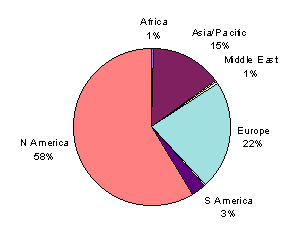
Figure 7.
The on-line world in Sept 1998
(Data: World Bank
Indicators)
With Less than one percent of the world that is
on-line in the Middle East (exclusive of Israel), elitism is
part of its significance in three ways. First, Internet use in
Arab countries is currently concentrated in Gulf countries,
nominally the most censorious. The crucial variable is not
cultural policy but infrastructural investment in
telecommunications, in which Gulf countries are regionally in
the van, which is reflected in Figure 8 (with Israel for
comparison). These numbers include domestic users only (thus
excluding, for instance, Saudi subscribers to ISPs in
Bahrain).
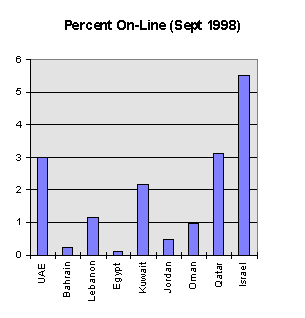
Figure 8.
Percent of adult populations with ISP subscriptions
(Data:
World Bank Indicators, Dabbagh Information
Technology)
Second, the numbers are growing rapidly,
suggesting a "submerged" elite coming to light as Internet
users. Projections from limited data currently available show
the same divergence in rates of growth as in overall numbers,
and the dependence on a mix of the physical and social
availability of access to the Internet.
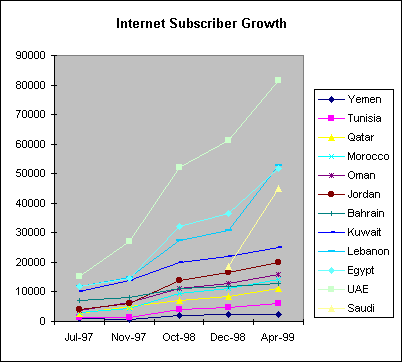
Figure 9.
ISP Customer growth in thousands
(Data: Dabbagh
Information Technology)
Third, as already indicated, Internet use is
concentrated within the provider community, and among those
most like it socially and educationally. Put differently, it
is a medium that puts their values and views into action, the
values and views of a professional bourgeoisie with
transnational capabilities and local roots, commitments to
both, and capable of moving between them.
If the Internet is the leading edge, then
elevision, which has more than a generation head-start, is the
lagging one. It is by far the most ubiquitous medium here, as
elsewhere, and continues its role as a training ground for the
skills of mediated communication. As television evolves
through multi-channel formats with more diverse local and
regional content mixed with international content toward the
even more participatory and interactive model of the Internet,
the significance of television and of other media is likely to
be as a pre-adaptation for post-mass media technologies
generally. Current technology ties the Internet more closely
to telecommunications and to print and to new technologies
than to broadcasting (Fig 10). As the technologies are
converging -- already in the business plans implied in buyouts
of Internet startups and service providers in Jordan, Saudi
Arabia, and the Gulf -- the larger social significance of
these technologies and media is to have created a context and
fostered habits that transfer quickly to post-mass media. The
Internet may be something new, and a public sphere of new
people, but it is drawn into pre-understandings already
developed through experience with other media and in other
social relations of media consumption. Saudi authorities for
instance, have announced an Internet policy along the same
lines, and with the same structure, as plans for providing
satellite television in the Kingdom from government gateways
to commercial distributors. The convergence, in other words,
is social, and social (in imagined uses) before it is
technological (implementing those uses). In this sense,
television and newspapers create the context and
telecommunications provides the channel for the model
technology toward which convergence is bringing them.
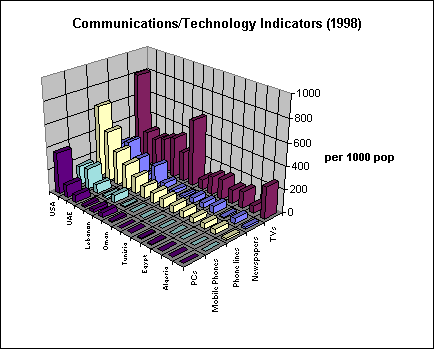
Figure
10. Communications Media per 1000 households
(Data: World
Bank Indicators)
Contrary media trends and cultural affects reflecting newer
roles for and conceptions of citizens and the public sphere
surfaced in December 1998 and demonstrate this broader
convergence. After the Arab States Broadcasting Union rejected
the application of al-Jazeera TV, the new Qatar-based news and
discussion channel distributed by satellite throughout the
Arab world, and gave it six months "to conform with the Arab
media code of honor" which "promotes brotherhood between Arab
nations," the brief wire service report of this story was
posted on Arabia.On.Line (AROL), a three-year-old Jordanian
World Wide Web site. Technology and its adepts thus undermine
an information regime of privileged arbiters of public
discourse, and did so with cultural skill as well: no further
comment was necessary for Arab readers to grasp the
significance of this attempt or its tropes.
Conclusion: a fateful conjuncture.
The media future that can be adduced begins with more
channels and alternative channels for messages, more variety
and wider participation, more interactive as opposed to
receptive formats, more exposure of and to differences within
the region, more opportunities to envision and vicariously to
experience alternative selves. Their point of departure is a
broad transfer of interpretive habits and practices forged on
mass media into constructive practices of new, post-mass
media. The television revolution has arguably preadapted a
population, made up-market through a generation-long rise in
mass education, with sets of skills and dispositions to
rebalance the asymmetries of the mass media regime through
down-market technologies of new media.
The first results are a startling increase in agency for
those positioned in this frame. They include journalists,
particularly in the transnational media, purveyors of the
technology, diaspora professionals, and particularly the
creative in each of these sectors and in government.
Citizenship, in the sense of acting in the public sphere,
becomes more active in these contexts of expanding and
expanding access to mediated communication that rebalance
sender-receiver relationships into something more like the
reciprocities of everyday communication. A particularly
notable feature of this emerging public space is the posing
within it, explicitly and implicitly through exploration and
experimentation, of the question "man 'arabiyya" -- "Who is
Arabian?" -- as old boundaries loosen and messages migrate
over the heads of previous cultural arbitors, including those
tied to previously "new" media.
A base, there is a fateful convergence that is
technological, as different types of data (still and moving
pictures, music, voice, numbers) converge into a single
(digital) type independent of channel and designed to find its
own paths. It is also social, as activities particularly of
identity-mongering are absorbed into communication. The trend
in decentralized communication and "distributed" (as opposed
to centralized) responsibility intersects a two-generation
rise in mass education that is breaking traditional monopolies
on access to information and, more importantly, on rights to
interpret. And it includes reconnection with the Arab
disaspora populations and a new burst of transnational media
that, unlike literary pan-Arabism, involves a much broader
audience. The significance of these convergences is not
"globalization," if that means access to non-local
alternatives to Arab culture, but instead to highlight, even
to enable, alternatives within Arab culture to express and
experience alternative identities.
Enabling these cultural changes are structural changes in
communications regimes that follow from the communication and
information technology moving down-market at the same time
that regional populations are moving up-market. This
conjunction frames the passage of more and more indigenous
forms of regional culture into mediated communication. This,
in turn, opens up possibilities for exploring alternative
selves that, in some ways, is already a trend of the times.
That is, the larger problems of culture in this equation is to
shift from replication of uniformities to organization of
diversity. This may be the major challenge of the next
generation. A.R. Norton has provocatively updated earlier
suggestions that Middle East populations may well be
interested in liberalization without being in the least
interested in democratization, (17)
a process and cultural choice to which the contemporary
post-mass media already contribute.
Some Links to Related Material
Transnational
Media and Regionalism, by Jon Alterman.
Transnational Broadcasting Studies, 1, Fall 1998.
Is
the Internet Islam's 'Third Wave' or the 'End of
Civilization'? by Jon W. Anderson, USIP Conference on
Virtual Diplomacy, Washington, DC, 1-2 April 1997.
The mosque
and the satellite: Media and adolescence in a Moroccan
town, by Susan S. Davis & Douglas A.
Davis.
Iranians
on the Internet, by Haleh Nazeri, Middle East Studies
Association Bulletin, December 1996.
Notes & References
(1) Jon Anderson is Chair of Anthropology at
the Catholic University of America and co-director, with
Michael Hudson, of the Arab Information Project at Georgetown
University. He is co-editor, with Dale F. Eickelman, of New
Media in the Muslim World: The Emerging Public Sphere
(Bloomington: Indiana University Press, 1999) and author of
Arabizing the Internet (Occasional Paper # 30, Abu
Dhabi: Emirates Center for Strategic Studies & Research,
1998).
(2) Annabelle Sreberny-Mohammadi & Ali
Mohammadi. Small Media, Big Revolution: Communication,
Culture and the Iranian Revolution (Minneapolis:
Univeristy of Minnesota Press, 1994). A more extended,
"cultural" significance of cassette technology for circulating
popular culture is described in Peter Manuel's Cassette
Culture: Popular Music and Technology in North India
(Chicago: University of Chicago Press, 1993).
(3) M. Hakan Yavuz, "Media identities for
Alevis and Kurds." In Eickelman & Anderson, New
Media. 1999.
(4) Today's most prominent technological
optimist might be Nicholas Negroponte, whose Being
Digital (New York: Knopf, 1995) summarizes that vision
with respect to the Internet; against it might be set the
social history of the telephone in Claude Fischer's
America Calling (Berkeley: Univeristy of California
Press, 1992) or the popular account of how American television
is re-made by European viewers in Richard Pells' Not Like
Us (New York: Basic, 1997). The most grounded attempt to
think through the contemporary information revolution is
Manual Castells' three-volume The Information Age:
Economy, Society and Culture (New York: Blackwells,
1996-98), which is based, as are almost all such works, on
Daniel Bell's The Coming of Post-Industrial Society
(New York: Basic, 1973).
(5) These features were identified over a
decade ago by Ithiel da Sola Pool, whose last work on the
convergence of computing and communication was
Technologies Without Boundaries (Cambridge: Harvard
University Press, 1990). An updated, more journalistic version
of some of his key ideas, focused on telecommunications
developments, is Frances Cairncross' The Death of
Distance (Cambridge: Harvard Business School Press,
1997).
(6) This point is developed in "Conspiracy
theories, premature entextualization in popular political
analysis," Arab Studies Journal IV(1), 1996. On-line at http://www.arabstudiesjournal.org/spring1996_anderson.htm.
(7) See case studies of censorship,
government pr, the Internet, pulp novels, new law journals,
Islamic educational publications, the telephone, and
television in New Media in the Muslim World, edited
by Dale F. Eickelman and Jon W. Anderson (Bloomington: Indiana
University Press, 1999).
(8) "Mass higher education and the religious
imagination in contemporary Arab societies," American
Ethnologist (November 1992).
(9) The connection of the modern public
sphere with mediated -- as opposed to only face-to-face --
communication, on the one hand, and with public ritual, on the
other hand, was made in Juergen Habermas' The Structural
Transformation of the Public Sphere, translated by Thomas
Burger (Cambridge: MIT Press, 1991; orig., 1962); the notion
is applied in my "The Internet and Islam's new interpreters,"
in New Media in the Muslim World (1999) and for
diaspora communities specifically "Globalizing politics &
religion in the Muslim world," Journal of Electronic
Publishing 3(1), September 1997 (available on-line at http://www.press.umich.edu/jep/03-01/Anderson.html).
(10) The connection of what Benedict
Anderson called "print capitalism" with literacy, and with
public education, is underplayed in his now-classic study,
Imagined Communities (London: Verso, 1984), but given
more balance in Elizabeth Eisenstadt's The Printing Press
as an Agent of Change (Cambridge: Cambridge University
Press, 1979).
(11) Hani Yarid, "Masters of Arabic TV
drama," Arabia.On.Line (January 21, 1999), on-line at
http://www.arabia.com/content/living/1_99/cov\_drama.shtmlHani
Yarid . Also, John Lancaster, "Syria, The Hollywood of the
Mideast," The Washington Post (February 2, 1998), p. A14
(on-line at http://www.washingtonpost.com/wp/_srv/WPlate/1998/_02/02/050l/_020298/_idx.html).
(12) The term has been explicitly adopted
and used by Internet and satellite services in the region to
characterize their broad range of offerings.
(13) Dr. Marwan Muasher, "Introducing the
Internet in Jordan." Seminar at Georgetown University, 23
March 1999. (on-line at http://www.georgetown.edu/research/arabtech/Muasher.htm)
(14) Jon Alterman, New Media New
Politics: From Satellite Television to the Internet in the
Arab World. Policy Paper #48 (Washington: The Washington
Institute for Near East Policy, 1998).
(15) "Cybarites, knowledge workers and new
Creoles of the Information Superhighway," Anthropology
Today (August 1995).
(16) Survey data on-line from Dabbagh
Information Technology at http://www.dit.net/. On the
commercial context, see Jon W. Anderson. "The Internet and the
Middle East: Commerce Brings Region On-Line," Middle East
Executive Reports 20,12 (December 1997).
(17) A.R. Norton, "The new media, civic
pluralism, and the slowly retreating state." In New Media
in the Muslim World, edited by Dale F. Eickelman and Jon
W. Anderson (Bloomington: Indiana University Press, 1999).
Comments? Email the author, Jon Anderson
All Rights Reserved. May not be reprinted
in any format without permission of the
Author. |